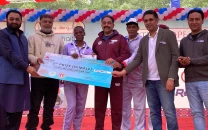Just add water

But across that expanse of sand the people on the other side have water. Small wonder then, that when the people of this desert outpost found water, they wanted to hold on to it. “God has been merciful with us and given us water,” says Hajan Samo, a 45-year-old resident of Samon Samo village of Umer Kot district, Thar. “But now they want to snatch it from us.”
Samo is referring to the Paramiliary Rangers force whose presence is mandated by a country next door. “When their personnel saw that we found water in this deserted area, they wanted to gain control of it,” Samo alleges. “Several times, a major along with other personnel have visited our village and asked us to move as they want to plant trees over here.”
The discovery of water in the bone-dry Thar is nothing short of a miracle for the people who have lived in drought for centuries. Since childhood, Samo has dreamt of drawing sweet water from the wells of his village which has always been brackish. His father used to travel 18km to fetch potable water on a donkey, a memory that is seared in Samo’s mind.
The discovery of water could have taken place a long time ago. People from the area approached Thardeep Rural Development Program (TRDP), saying that they knew of tube wells on the other side of the border, thus there could be some possibility of exploring on this side.
TRDP’s founding chairman Dr Sono Khankhrani told The Express Tribune that they initially dug till 1,000 feet but found nothing. “But later, as the people requested us, we went down 300 feet more and found a gigantic pressure of water upward,” he says. Thardeep put in about four million rupees to build with tanks and machinery.
But the problem is that the water is brackish. It is 3,500 parts per million (ppm) salinity, which was completely undrinkable. According to the World Health Organisation’s standards, water up to 800 ppm salinity can be safely drunk but not more than that. But because the discovery of water was such an amazing one, with water pouring out within 24 hours of digging, the villagers did not want to waste the opportunity.
Apparently, there was a layer of very porous rock or sediment capable of holding and transmitting large quantities of water in the area because of the Sarsvati River, which passes through Thar before entering the Arabian sea. Thardeep’s Jhaman Lal says that they highlighted the issue over the internet after which some non-government organisations from India approached them with a solution, the artesian aquifer.
This is a confined aquifer containing groundwater that will flow upward through a well, called an artesian well, without the need for pumping. Water may even reach the ground surface if the natural pressure is high enough, in which case the well is called a flowing artesian well. Thardeep approached the Sindh government for a Reverse Osmosis Plant that would convert the brackish water.
Today there is a total of seven artisan wells in the country with one of them in Thar. The well discharges 20 to 25 litres of water per second, which comes to around 380,000 gallons in 24 hours. “There is enough water that we could provide it to other villages, if there were a good communication system,” says Habib Samo, a herdsman.
Gone are the days when their animals were dying of thirst. Today the well has created a small pond that attracts birds and animals. “The only thing that we fear is the people from the paramilitary forces, who have been keeping an eye on it,” says Samo. For their part, however, the paramilitary rangers refute these allegations.
Spokesman Major Aurangzeb tells The Express Tribune that among the other responsibilities of the Rangers is the provision of water to communities. “So how can we threaten people into leaving their land?” he asks, adding that he would investigate the matter and contact the wing commander.



















COMMENTS
Comments are moderated and generally will be posted if they are on-topic and not abusive.
For more information, please see our Comments FAQ